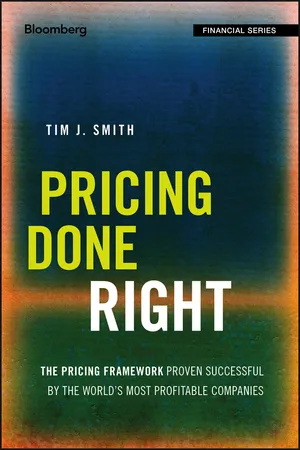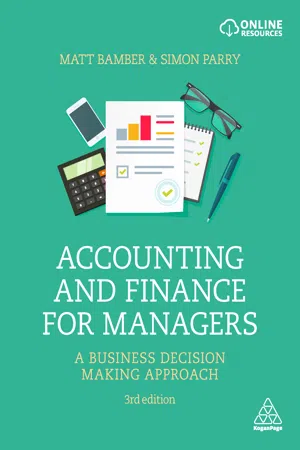Business
Pricing Decisions
Pricing decisions involve determining the optimal price for a product or service to maximize profits and meet customer demand. Factors such as production costs, competition, and consumer behavior are considered when setting prices. Businesses must carefully analyze market conditions and pricing strategies to achieve their financial goals while delivering value to customers.
Written by Perlego with AI-assistance
Related key terms
Related key terms
1 of 4
Related key terms
1 of 3
12 Key excerpts on "Pricing Decisions"
- eBook - ePub
Pricing Done Right
The Pricing Framework Proven Successful by the World's Most Profitable Companies
- Tim J. Smith(Author)
- 2016(Publication Date)
- Wiley(Publisher)
CHAPTER 6 Defining the Pricing Decision TeamWho does pricing? A key role of management is getting the right people doing the right things at the right time, but who are the people doing pricing? Who should be engaged in informing, developing, and implementing Pricing Decisions? How should executives structure the decision-making team? And what decisions should senior executives retain control over while pushing other decisions down into the organization?When a firm adopts value-based pricing, it is also adopting a different decision-making approach to pricing. Pricing Decisions made in one department can no longer simply be handed off to another department for execution. Rather, pricing decision-making itself becomes a cross-functional activity.To demonstrate the cross-functional nature of Pricing Decisions, consider that value-based pricing relies on understanding the perceptions of value from the customer’s orientation while ensuring that value can be delivered profitably. The full understanding and knowledge of customers’ perceptions and the firm’s costs is dispersed throughout different functional areas of a firm. As such, making good value-based Pricing Decisions requires gathering these inputs from these functional areas across the organization.Or, consider that acting on Pricing Decisions usually requires passing information across functional departments and having that decision implemented by a functional area that may not be under the direct control of the department that drove the decision. To have a decision as important as pricing made by one functional area and implemented by another, cross-functional buy-in to the decision itself is necessary.These issues and others turn the question of “who makes Pricing Decisions” from a singular to a plural. For any decent size corporation, pricing isn’t a one-person decision, nor is it a one-function decision, but rather, value-based pricing requires a team - eBook - ePub
- Marilyn Stone(Author)
- 2007(Publication Date)
- Routledge(Publisher)
Generally, it is acknowledged that Pricing Decisions are the most difficult to make because of the complexity of the interaction between three groups involved in the marketing process: consumers, the trade and competitors. In addition Pricing Decisions often have to be made quickly and with limited, or even no, test marketing. They almost invariably have a direct effect on profit.Among consumers, price is the principal determinant of choice. Its significance is further emphasized by price being the only element among the four marketing mix components that generates revenue – the others produce costs.Frequently, a series of mistakes are associated with pricing, the most common of which are:- Being too cost-oriented, i.e. biasing prices towards costs and overlooking competitor or customer probable response patterns.
- Setting prices in isolation from other elements of the marketing mix.
- Ignoring opportunities for differentiation.
- Setting standard prices across different market segments.
- Setting prices as a defensive response rather than an offensive approach to market conditions.
- Holding prices nominally consistent for too long, i.e. not reviewing pricing in line with market changes.
Taken together, these points suggest that Pricing Decisions run the risk of emerging largely as a result of habit rather than of detailed strategic thinking. The haphazard approach to pricing is compounded by the ways in which responsibility for setting prices is allocated within many firms. It is standard practice for Pricing Decisions to be made by senior management rather than sales and marketing staff who are likely to be closer to the end consumer. This chapter considers why pricing should be the responsibility of the marketing department. It also covers the merits of the various approaches to pricing and the influence of environmental factors on the pricing process. - eBook - ePub
- Geoffrey Lancaster, Lester Massingham(Authors)
- 2017(Publication Date)
- Routledge(Publisher)
5 Pricing strategiesLearning objectives
After reading this chapter you will:• appreciate the strategic significance of Pricing Decisions in marketing strategy;• understand the approaches to pricing of the economist and accountant, together with their contributions and limitations in the context of the price-setting process;• be able to apply a framework to Pricing Decisions based around the key inputs to these decisions;• understand the main pricing methods and their relative advantages and disadvantages.Introduction
The price of a company’s products and services represents the vehicle for that company to achieve its financial objectives. It is through price and volume that revenue is generated. Price equates to the financial sacrifice that the customer is willing to make to purchase the product or service desired.The important criterion of pricing is problematical to marketers. This is attributed to the uncertainty associated with Pricing Decisions as it is a complicated area of decision-making. It is with a view to examining this problem and the ways in which it can be resolved that this chapter is framed. The pressures of today’s market environment place increasing burdens on management. It is important, therefore, that the decision-maker has a framework for making Pricing Decisions. We start by examining the traditional economist’s view of price to illustrate both the shortcomings and potential contributions of this approach as a prelude to discussing more strategic pricing approaches for the decision-maker.The economist’s view of pricing
Traditionally the economist has looked at price and Pricing Decisions from the perspective of the interplay of demand and supply. At a broader level, the economist views Pricing Decisions as an ‘allocatory’ mechanism, with prices being used as the signal to solve the basic problems of an economic society: namely, the allocation of scarce resources between competing users and individuals in that society so that resources are used in the most effective way. From the perspective of the price setter, traditional economic theory suggests that the ‘optimum’ price is one that equates marginal costs to marginal revenue so as to ‘maximize’ profits. - eBook - ePub
The 30 Day MBA in Marketing
Your Fast Track Guide to Business Success
- Colin Barrow(Author)
- 2023(Publication Date)
- Kogan Page(Publisher)
07Pricing
- Understanding the economics of demand
- Assessing market structures
- Recognizing the components of cost
- Strategic pricing options
- Identifying unprofitable products and services
Business schools, as you might expect, take the subject of pricing very seriously; their elevated fee structures confirm this. None more so than at the Wharton School, University of Pennsylvania, where Jagmohan S Raju, a leading authority on competitive pricing strategy, resides as Joseph J Aresty Professor. Here students spend the equivalent of four full days systematically studying pricing strategies designed to capture maximum value, under all types of market conditions. These include complex situations such as pricing new products, products with short life cycles, dynamic pricing, and where products and services are bundled together into a single proposition. Professor Raju contrasts the systematic approach he and professors at other business schools take with the ad hoc or trial-and-error approach to pricing taken by most businesses, which his research shows can significantly reduce a firm’s bottom line.For the MBA student, pricing straddles a number of academic disciplines. Economics provides the big picture, a macro, external overview of factors that affect demand, including the nature of the market and competitive structure the firm faces. Accountancy provides the micro framework for understanding the characteristics of a firm’s cost structure, how that changes with changes in volume and consequently how to set target prices to achieve desired profit goals. Marketing strategy is used to provide frameworks for determining pricing policies and procedures. Finally, a blend of all these disciplines can be used to eliminate products and services that are unlikely to achieve price levels that will meet profit goals.Economic theory and pricing strategy
The main economic concept that underpins almost the whole subject of pricing is that of price elasticity of demand. The concept itself is simple enough: the higher the price of a good or service, the less of it you are likely to sell. Obviously it’s not quite that simple in practice: the number of buyers, their expectations, preference and ability to pay, the availability of substitute products. - eBook - ePub
Marketing (RLE Marketing)
The Management Way
- Arnold K. Weinstein(Author)
- 2014(Publication Date)
- Routledge(Publisher)
We have previously mentioned the role of judgement in pricing. Intuitive prices are based on executives feeling that they are correct. Administering PricingThis concept usually applies to situations where sellers maintain the same selling price over long periods of time. The market is usually oligopolistic with a strong price leader. Non-price competition is more prevalent than price competition.“Certain common elements appear to stand out which distinguish business practice from economic theory: 1. Businessmen appear to rely on costs much more formally than demand when making Pricing Decisions. This is in large measure due to their better ability to estimate this side of the coin. 2. The costs chosen, however, are primarily full, historical costs rather than the incremental, future costs of the theoretical economist. 3. The competitive role seems to be taken into account more on a defensive than offensive basis; that is, the implication may be ‘leave well enough alone’.4. Emphasis appears to be more on safeguarding a ‘normal profit,’ than accepting the assumed greater risk associated with the policy of price setting for maximum profit.”11Multi-Stage Approach to Pricing12The multi-stage approach to pricing is a six-step procedure. It explains in qualitative terms what the pricing executive must consider when making a pricing decision. The steps are as follows: 1. Select market targets. 2. Select brand image. 3. Select marketing mix. 4. Select price policy. 5. Select price strategy. 6. Select specific price.Selection of Market Targets: - eBook - ePub
- Paul Reynolds, Geoff Lancaster(Authors)
- 2005(Publication Date)
- Routledge(Publisher)
Pricing
DOI: 10.4324/9780080455020-77.1 Introduction
The end price of a company’s products or services determines of the amount of money the company can make. Company objectives are guided and influenced by market conditions and price must be a function of such conditions, so the achievement of company objectives often necessitates compromise over the amount of profit that can be realised. The importance of price as a function of the marketing mix varies from market to market, but it is not always the most important factor in the buyer’s decision-making process. For the seller, as price determines the amount of profit or loss, it is crucial that pricing is approached in a disciplined and orderly manner. Price provides revenue, whilst other elements of the marketing mix represent costs (see Jobber, 2004 , p. 375).Cost-orientated approaches to pricing are sometimes criticised. This is justified in that costs do not necessarily reflect market conditions or company goals at least in the longer term. Marketing strategies can be designed that put costs into the perspective of a long-range strategic approach. For example, the acquisition of a high market-share may drive down costs in the long term. An imagebuilding strategy might invoke high costs initially, but it allows the company to charge higher prices in the long term. A purely cost-orientated approach to pricing might be too narrow as a basis for pricing. Cost is, however, the logical starting point, and prices charged must ultimately exceed costs if the company is to remain in business. Tellis explains:‘A strategy is a broad plan of action by which an organisation intends to reach its goal. A policy is more of a routine managerial guide to be implemented when a given situation arises. Giving certain price discounts when a certain amount of product is ordered in an example of a policy.’ - eBook - ePub
Accounting and Finance for Managers
A Business Decision Making Approach
- Matt Bamber, Simon Parry(Authors)
- 2020(Publication Date)
- Kogan Page(Publisher)
Another important aspect of marketing is the recognition that not all customers will behave in the same way. For a given product within a given market, some customers will have relatively high price elasticity of demand whereas other customers will have relatively low price elasticity of demand. An important skill in marketing is identifying and targeting different groups of customers according to their willingness to pay. An example of this is supermarkets which have a ‘value’ range of products for thrifty customers, a normal range of products for the majority of customers, and a premium or luxury range of products for better-off customers.Discussion pointList as many clothing retailers as you can, then place each retailer within the ‘product positioning’ grid in Figure 8.7 .Combining the three perspectives: establishing an appropriate pricing strategy
Now that we have looked at the different issues which go into the pricing decision and the factors which influence prices, we can look at how organizations should consider these when establishing pricing strategies. Figure 8.8 sets out a range ofdifferent pricing strategies. Before we look at these in detail, we need to consider some general principles. Firstly, the long-term pricing strategy of an organization should be in line with the organization’s mission and broader strategic objectives. Secondly, any pricing strategy adopted should always be informed by all three C’s of pricing discussed above: costs, competitors and customers.Broadly speaking, there are three considerations that will help the business frame an appropriate pricing strategy. These relate to the following questions:- Are we pricing a new or existing product or service?
- Are we going to a new or existing market?
- Are we a volume-driven or a price-driven business?
New product or existing product?
If a business is launching a new product or a product with substantial new features (ie one that is not currently offered by any competitor), there will be no competition for that product. This may mean a relatively inelastic demand and a high level of interest in the product. On the other hand, if the business is launching a product which is similar to those already available from competitors, it needs to compare that new product with those already available. Are the features comparable? Are there new or unique features? These factors will impact upon the business’s ability to charge higher prices. For example, when Apple launched the iPad there were no comparable products available. This, together with the relative price inelasticity of the market, enabled Apple to charge high prices for their new product. However, as other competing manufacturers launched similar products they had to price more competitively in recognition of the fact that there were several substitute products available. - eBook - ePub
- Douglas Hague(Author)
- 2018(Publication Date)
- Routledge(Publisher)
We argued that, in an ideal world, conflicts between objectives would be identified and different objectives given appropriate weights. We went on to suggest that the firm was unlikely to go so far as to establish a ‘goal index’ which would give precise weight to different objectives and so provide a basis for Pricing Decisions. However, this is a future possibility that should not be forgotten. We argued that at present all one could do was to rank pricing objectives in a way that would allow the firm to give roughly the intended weight to each of them in Pricing Decisions. Finally, we suggested that the firm should ensure that each individual responsible for Pricing Decisions, at whatever level in the firm, needed to be absolutely clear what objective(s) he was expected to pursue. Only in this way could sub-optimization (or indeed non-optimization) be kept to a minimum.The first step in any pricing decision is therefore to go through the steps set out in Sections A and B of the check list. The person responsible should ensure that the product to be priced and the nature of the pricing decision are identified, and the objectives clearly understood by everyone concerned with the decision. The second step is to obtain the optimal amount of relevant information, as suggested in Sections C and D of the check list, and to analyse it on the lines we discussed in Chapters 7 and 8 .9.2 THE ALTERNATIVESWe now move on to the decision itself and things become more complicated still. We are no longer concerned separately with the way in which, say, costs alter with changes in output, or in output per man; or by how much the amount sold is increased by reducing price. We are concerned with cost and demand factors at the same time. We have to look at the effects which a change in price has on both demand and output, and so on costs and profits. If advertising, or other sales promotion activities alter too, even more variables have to be watched. We are concerned with relationships between a number (perhaps a large number) of interrelated variables. - eBook - ePub
Innovation in Pricing
Contemporary Theories and Best Practices
- Andreas Hinterhuber, Stephan Liozu, Andreas Hinterhuber, Stephan M. Liozu(Authors)
- 2017(Publication Date)
- Routledge(Publisher)
Most pricing practitioners agree that pricing orientation and the lack of scientific and systematic return on investment (ROI) calculations for pricing strategies constrain visibility of pricing in the C-suite and restrain firm adoption of modern pricing approaches. In addition, marketing and pricing literature is silent about both the consequences of pricing orientations on overall company performance (Ingenbleek, 2007; Hinterhuber, 2008b) and, more specifically, on how value-based pricing might lead to superior firm performance. Perceived value-based pricing is a pricing practice whereby managers make decisions based on customer perceptions of product benefits and how these benefits are weighted by the customers relative to the price they pay (Ingenbleek et al., 2010). Ingenbleek et al. (2003) demonstrated that value-based pricing is a key pricing practice for obtaining larger returns and for creating a comparative advantage for the company’s products. This was demonstrated in a study conducted by Füreder et al. (2014) on medium-sized companies in Austria that showed higher contribution margins when accompanied by the perceived value-based pricing strategy.Competition-based pricing uses competitors’ price levels and behavior expectations as key sources of information to determine pricing (Liozu & Hinterhuber, 2012). The main advantage of this approach is considering the actual pricing situation of the competitors. Its main disadvantage is that demand related aspects are not considered. Furthermore, a strong competitive focus among competitors can increase the risk of starting a price war in the market (Heil & Helsen, 2001).Cost-based pricing is the simplest and most popular method for setting prices because it carries a sense of financial judgment, which involves adding a profit margin on costs, such as adding a standard percentage contribution margin to the products and services. First, sales revenue is determined; then the unit and total costs are calculated; followed by a check of the company’s profit objectives; and, finally, establishing the prices. Thus, from a pricing professional perspective, it is necessary for customers to perceive enough value in products and commercialized services to justify the prices charged by the company.Pricing strategies may be seen as a process that requires a good understanding of the internal structure of the company, a good knowledge of the market and a good knowledge of the diverse variables that comprise it and their interfaces. The price is considered one of the most impacting elements in companies’ performance. Ingenbleek et al. (2003) tested the relationship between pricing approach and new product success and found value-informed pricing had the overall strongest positive effect on product performance. A subsequent study (Ingenbleek et al., 2010) showed value-informed pricing positively influenced new product market (but not new product financial) performance, noting the latter link may require a more complex model including data on sales, costs and other information (Ingenbleek et al., 2010). - eBook - ePub
- Mick Broadbent, John Cullen(Authors)
- 2012(Publication Date)
- Routledge(Publisher)
The economic literature considers the price of a good or service from the viewpoint of the type of market the firm is operating within, using terminology which includes perfect market, oligopoly, and monopoly. The literature considers that different market conditions will impact on the ability of a firm to affect price. The marketing literature sees price as one decision variable within the marketing mix, or total product offering, of that particular product or service. The emphasis is on the requirement of the customer and the proactive ability of the firm to influence the market. The strategic literature sees price as a variable within the ‘value chain’ and the establishment of a generic strategy for the firm to generate and maintain competitive advantage. The establishment of long-term competitive advantage may be through relative cost advantage, hence the inclusion of target costing within this chapter. The accountant’s contribution and the cost approach to pricing views price as a residual figure established from the cost data within the organization. While this view may provide basic data for a range of viable selling prices, the actual price set must be seen as a complex, interactive decision resulting from the inputs of many variables. To place the accountant’s pricing approach in context it would be useful to view Figure 9.1, which has been used in other chapters. This chapter explores the ideas of cost classification, introduced in Chapter 4, by applying the different cost models to arrive at selling prices. The data collection system holds information about costs which may be classified in various ways, direct and indirect, fixed and variable, controllable and uncontrollable, to mention only three. The process of accounting may assist in reaching decisions about selling prices based upon these different cost classifications - eBook - ePub
International Marketing (RLE International Business)
A Strategic Approach to World Markets
- Simon Majaro(Author)
- 2013(Publication Date)
- Routledge(Publisher)
We have tried to look at the influence that marketing objectives may have on Pricing Decisions. We listed a number of pricing objectives that stem from corporate and marketing aims and the international implications of such objectives. The list is by no means comprehensive and the point to remember is that a few of the pricing objectives listed are complementary rather than mutually exclusive. Return on investment and market penetration objectives are perfectly compatible. On the other hand market stabilisation and loss leadership may well be in a state of total contradiction. The marketer's job is to ensure that the price selected for a product in its international setting fulfils the various objectives envisaged by the marketing plan and at the same time meets the needs of the market-place. Performing such a task in an international environment calls for considerable skill.The Mechanics of Pricing Decisions for International Marketing
It is important to review briefly the various methods that are available to the marketer in trying to select the most appropriate price for a product destined to be sold in world markets. Most of these methods are similar to those used by the domestic counterpart when choosing a price for his home market. The differences stem from size and geography rather than methodology.The various methods and their international implications can be summarised thus:1 Prices Based on Costs
This is the simplest approach and is normally based on the way the accountant would determine a price for a product. The firm calculates the total cost of the product, including production and marketing costs, plus an allocation of overheads and then adds a percentage to represent a margin of profit. The total yields a selling price.The trouble with this method is that the cost calculation is based on a predetermined level of activity. It tends to disregard the fact that costs do not act alike as output increases or decreases. Moreover, it takes little cognisance of markets, their dynamism and elasticities. This is particularly true in international markets where minimal elasticity can translate itself into substantially increased volume, stemming from the fact that the global scene is so large.2 Market Demand versus Break-Even Analysis
The aim here is to try to calculate the break-even point at several demand points based on different selling prices. This method tries to explore the effect that different prices may have on demand and the impact of both on the break-even point. This approach brings into consideration the effect of elasticity and tries to find the most profitable supply/demand relationship at a given price level. Having carried out such an exercise the marketer can decide which level of activity would best meet his profit and marketing objectives. - Bonita M. Kolb(Author)
- 2016(Publication Date)
- Routledge(Publisher)
issues must be considered. The first issue is to determine the organization’s pricing goals. Other Pricing Decisions arise for products that are new to the marketplace, such as whether to use penetration or skimming. Once introduced, the organization may need to change pricing during the product life cycle. Finally, products purchased for resale will be priced using markup. In all of these situations, the organization should not engage in unethical pricing.- One of the primary pricing methods is cost-based, where the product is calculated using the breakeven point, which is based on variable and fixed costs. If this is not appropriate, which is true for service products, in particular, the price may be based on competitor prices. The final method is value-based, where the price is based on what consumers are willing to pay, whether it is a high or a low price.
- Special pricing tactics include temporary price discounts aimed at enticing consumers to buy when demand is low. Pricing tactics for businesses usually focus on quantity discounts. Professional services have their own pricing model based on either an hourly fee or based on tasks.
The meaning of price
Pricing per hour can cost you moneyPricing a product can seem so simple. You just need to charge for your work based on the hours spent producing the creative product. However, there are problems with this approach that can cost you money. One problem inherent in pricing by the hour is that as you get better at producing a product, it will take less time. Therefore, your price will decline. But shouldn’t people be paying more, not less, for skill and experience?On the other hand, if you try a new experimental technique that results in the product taking twice as long to produce, your price will double. Why should a consumer have to pay double for a product because of your production technique if he or she sees no difference in the final product? While time spent on producing a product should be a consideration when pricing, other factors should also be considered.
Index pages curate the most relevant extracts from our library of academic textbooks. They’ve been created using an in-house natural language model (NLM), each adding context and meaning to key research topics.
Explore more topic indexes
Explore more topic indexes
1 of 6
Explore more topic indexes
1 of 4











